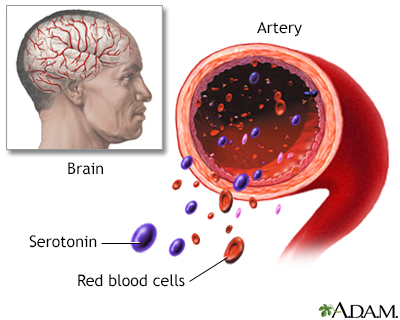Pregnancy SmartSiteTM
Flush syndrome; Argentaffinoma syndrome DefinitionCarcinoid syndrome is a group of symptoms associated with carcinoid tumors. These are tumors most often of the small intestine, colon, appendix, or bronchial tubes in the lungs. CausesCarcinoid syndrome is the pattern of symptoms sometimes seen in people with carcinoid tumors. These tumors are rare, and often slow growing. Most carcinoid tumors are found in the gastrointestinal tract and lungs. Carcinoid syndrome occurs in very few people with carcinoid tumors, after the tumor has spread to the liver or lung. These tumors release too much of the hormone serotonin, as well as several other chemicals. The hormones cause the blood vessels to open (dilate). This causes carcinoid syndrome. SymptomsThe carcinoid syndrome is made up of four main symptoms including:
Symptoms are sometimes brought on by physical exertion, or eating or drinking things such as blue cheese, chocolate, or red wine. Exams and TestsMost of these tumors are found when tests or procedures are done for other reasons, such as during abdominal surgery. If a physical exam is done, the health care provider may find signs of: Tests that may be done include:
TreatmentSurgery to remove the tumor is usually the first treatment. It can permanently cure the condition if the tumor is completely removed. If the tumor has spread to the liver, treatment involves either of the following:
When the entire tumor can't be removed, removing large portions of the tumor ("debulking") can help relieve the symptoms. Octreotide (Sandostatin) or lanreotide (Somatuline) injections are given to people with advanced carcinoid tumors that can't be removed with surgery. People with carcinoid syndrome should avoid alcohol, large meals, and foods high in tyramine (aged cheeses, avocado, many processed foods), because they may trigger symptoms. Some common medicines, like selective serotonin reuptake inhibitors (SSRIs), such as paroxetine (Paxil) and fluoxetine (Prozac), may make symptoms worse by increasing levels of serotonin. However, do not stop taking these medicines unless your provider tells you to do so. Support GroupsLearn more about carcinoid syndrome and get support from:
Outlook (Prognosis)The outlook in people with carcinoid syndrome is sometimes different from the outlook in people who have carcinoid tumors without the syndrome. Prognosis also depends on the site of tumor. In people with the syndrome, the tumor has usually spread to the liver. This lowers the survival rate. People with carcinoid syndrome are also more likely to have a separate cancer (second primary tumor) at the same time. Overall, the prognosis is usually excellent. Possible ComplicationsComplications of carcinoid tumors may include:
A fatal form of carcinoid syndrome, carcinoid crisis, may occur as a side effect of surgery, anesthesia or chemotherapy. When to Contact a Medical ProfessionalContact your provider for an appointment if you have symptoms of carcinoid syndrome. PreventionTreating the tumor reduces the risk of carcinoid syndrome. ReferencesNational Cancer Institute website. Gastrointestinal carcinoid tumors treatment (Adult) (PDQ) - health professional version. www.cancer.gov/types/gi-carcinoid-tumors/hp/gi-carcinoid-treatment-pdq. Updated August 19, 2022. Accessed October 13, 2022. Öberg K. Neuroendocrine tumors and related disorders. In: Melmed S, Auchus RJ, Goldfine AB, Koenig RJ, Rosen CJ, eds. Williams Textbook of Endocrinology. 14th ed. Philadelphia, PA: Elsevier; 2020:chap 45. Wolin EM, Jensen RT. Neuroendocrine tumors. In: Goldman L, Schafer AI, eds. Goldman-Cecil Medicine. 26th ed. Philadelphia, PA: Elsevier; 2020:chap 219. | |
| |
Review Date: 8/15/2022 Reviewed By: Todd Gersten, MD, Hematology/Oncology, Florida Cancer Specialists & Research Institute, Wellington, FL. Review provided by VeriMed Healthcare Network. Also reviewed by David C. Dugdale, MD, Medical Director, Brenda Conaway, Editorial Director, and the A.D.A.M. Editorial team. The information provided herein should not be used during any medical emergency or for the diagnosis or treatment of any medical condition. A licensed medical professional should be consulted for diagnosis and treatment of any and all medical conditions. Links to other sites are provided for information only -- they do not constitute endorsements of those other sites. No warranty of any kind, either expressed or implied, is made as to the accuracy, reliability, timeliness, or correctness of any translations made by a third-party service of the information provided herein into any other language. © 1997- A.D.A.M., a business unit of Ebix, Inc. Any duplication or distribution of the information contained herein is strictly prohibited. | |

 Serotonin uptake
Serotonin uptake
